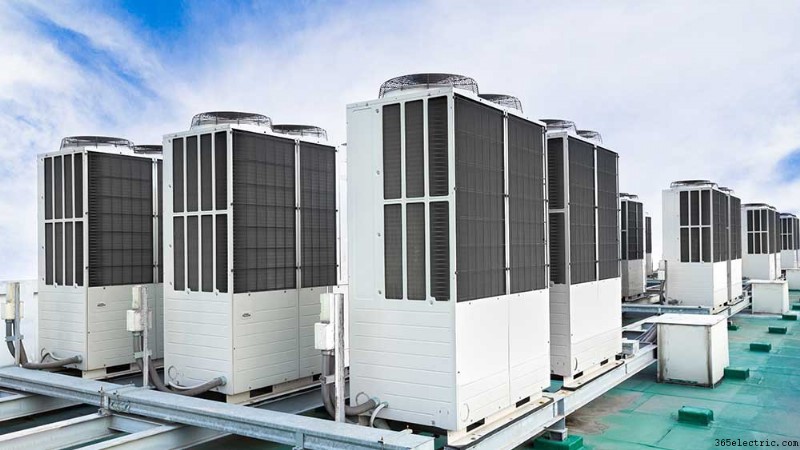
Os sistemas comerciais de climatização são um aspecto crucial de qualquer edifício. A manutenção da temperatura, umidade, qualidade do ar e muito mais depende de um sistema HVAC que funcione bem. Se falhar, você pode enfrentar uma perda infeliz de renda, reparos e clientela. Isso torna extremamente importante manter esses sistemas bem mantidos e oscilantes ao longo do ano.
Devido à sua grande escala, os sistemas comerciais de aquecimento e refrigeração podem ser complexos e difíceis de entender. Aqui está um resumo fácil de tudo o que você precisa saber para manter os condicionadores de ar comerciais em excelentes condições!
Componentes-chave de sistemas HVAC comerciais
Existem vários tipos diferentes de sistemas comerciais de aquecimento e refrigeração, mas todos eles têm os seguintes componentes essenciais:
1. Unidade de Ar Condicionado
Esta parte de um sistema HVAC comercial é responsável por diminuir ou aumentar a temperatura dentro de um edifício trabalhando com outros subsistemas.
2. Manipulador de ar
O manipulador de ar sopra ar refrigerado ou aquecido no prédio e, em seguida, retorna o ar de volta ao sistema. Possui serpentinas evaporadoras contendo refrigerante e um soprador.
3. Compressor
Esta é uma parte muito importante de um sistema HVAC. Ele altera o volume, densidade e temperatura do refrigerante.
4. Condensador
O condensador recebe o refrigerante do compressor e o transforma em líquido. Isso serve como o trocador de calor do sistema HVAC. Ao arrefecer, expele o calor do seu edifício e, ao aquecer, recolhe o calor do exterior.
5. Válvula de expansão térmica
Isso resfria o refrigerante líquido a ser bombeado de volta para as bobinas.
6. Unidades terminais
Essas unidades controlam a quantidade de ar que entra em cada zona através de dutos. Eles também têm filtros de ar para manter o ar livre de sujeira e detritos.
7. Termostato
Ele sinaliza ao seu sistema HVAC para produzir ar frio ou quente com base na faixa de temperatura definida. Edifícios comerciais podem ter vários termostatos instalados em várias salas.
8. Dutos
A maioria das unidades de dutos comerciais possui um sistema de dutos que ajuda a distribuir o ar condicionado por todo o edifício.
9. Resfriadores
Estes são os elementos de resfriamento de uma grande unidade HVAC comercial. Os resfriadores removem o calor do líquido que passa pelas tubulações de um prédio. Algumas unidades HVAC possuem chillers refrigerados a ar, enquanto outras possuem chillers refrigerados a água.
Tipos de sistemas comerciais de climatização
Existem várias opções para escolher um sistema comercial de aquecimento e resfriamento. Cada tipo tem suas vantagens e desvantagens, por isso é importante considerar suas necessidades específicas antes de decidir. Pode ser muito confuso anotar todos os detalhes, por isso é sempre bom discutir com um profissional depois de restringir suas opções. Vejamos em detalhes todos os tipos de ar condicionado comercial:
1. Ar Condicionado Embalado
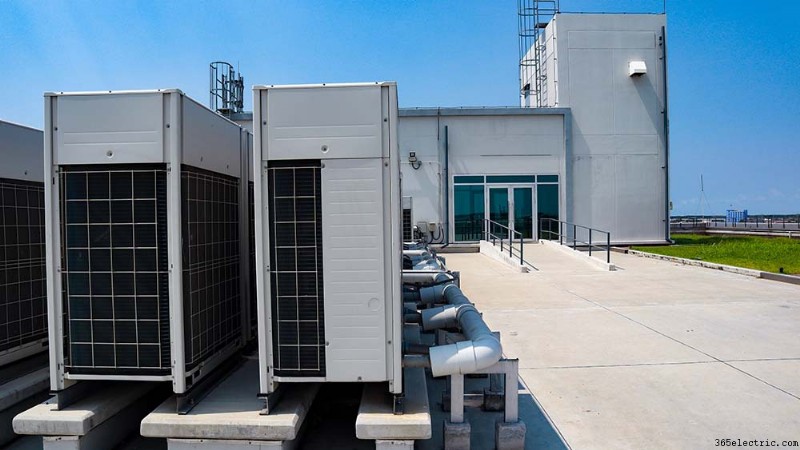
Um condicionador de ar embalado comercial é semelhante a um condicionador de ar de janela, mas muito maior em tamanho. Estas unidades comerciais de AC têm uma capacidade de aquecimento e refrigeração superior que varia de 3 a 15 toneladas.
Os ACs empacotados têm um design tudo-em-um contendo um condensador, compressor, ventiloconvector e evaporador. Estes são geralmente montados no exterior ou em telhados em edifícios como asilos, hospitais e condomínios. O ar condicionado é espalhado por todo o edifício por uma rede de dutos escondidos no teto.
| PRÓS | CONS |
| Baixos custos de instalação | Vida útil limitada |
| Simple maintenance requirements | High refrigerant costs |
| Quiet operation | High sensitivity to blocked air filters |
2. Split System
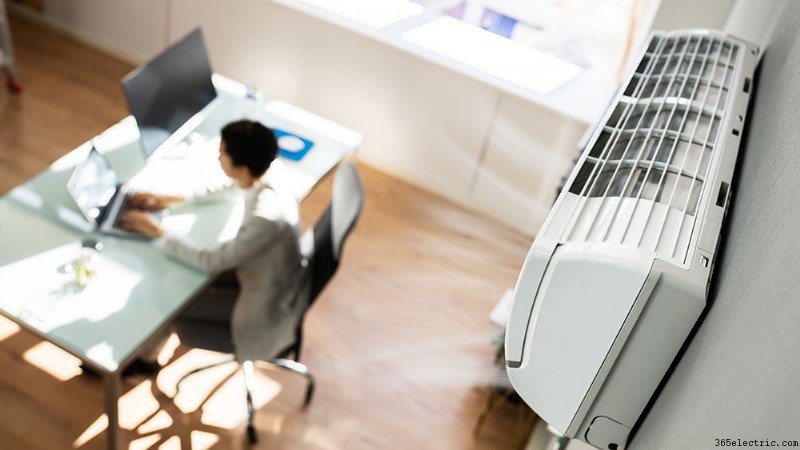
As the name suggests, a split system has two parts; an indoor and an outdoor unit. Commercial split air conditioners further have two types:
This is an affordable, energy-efficient commercial heating and cooling option for small buildings, cafes, server rooms, or shops. They are ideal for individual room cooling but can be used in combinations to condition multiple rooms. However, because each air conditioning unit needs a separate outdoor unit, this clutters the external space of the building.
| PROS | CONS |
| Ideal for small spaces | Multiple outdoor units clutter the space |
| Energy efficient | Not suitable for large buildings |
| Can be used as an additional source of air conditioning |
|
| Less expensive to install | |
In a multi-split system, one outdoor unit operates multiple inside indoor units. These systems require extensive pipework and, if not installed properly, can reduce the efficiency of your system.
Multi-split system is better suited for medium-sized buildings like restaurants or retail shops.
| PROS | CONS |
| It takes up less space | Higher installation cost |
| Preserves the building’s external appearance | Lots of pipework is needed |
| Ductwork isn’t required | Not suitable for small commercial spaces |
3. Heat Pump
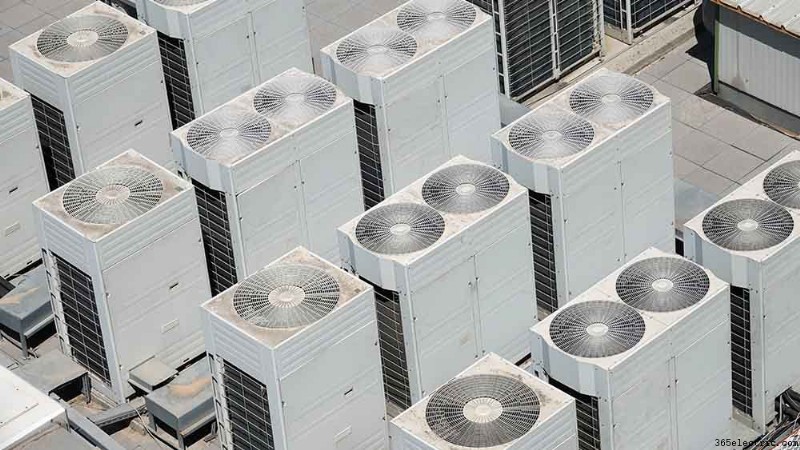
A heat pump heats or cools a building by transferring heat outside in the summers and inside in the winters. Since heat pumps do not generate heat, they can efficiently maintain comfortable temperatures. However, they’re not suitable in areas with extreme climate conditions.
Heat pumps can be ducted as well as ductless. Ducted heat pumps are suitable for larger areas but require extensive ductwork. Ductless heat pumps are ideal for supplemental or individual room cooling.
| PROS | CONS |
| Most energy efficient | Not suitable for colder climates below 40 degrees |
| Require less maintenance | Installing/cleaning ducts can be a hassle |
| Do not produce carbon monoxide | |
| Great for large and medium-sized buildings | |
| Quick installation if ductwork is installed | |
4. Variable Refrigerant Flow (VRF) or Variable Refrigerant Volume (VRV)
VRF or VRV is a ductless system that uses the minimum energy to attain the required temperature. It varies the refrigerant volume to match the precise requirements of a building. If the system requires more cooling, more refrigerant will enter the pipes. Because of varied compressor speed and no duct involvement, these units are considered much more efficient than the traditional HVAC units. Its mechanism results in lower energy costs and the long-term sustainability of the unit.
| PROS | CONS | |
| Saves energy bills | Expensive equipment | |
| Suitable for spaces with variable cooling or heating requirements | Takes a lot of space | |
| Better humidity and temperature control | Backup condenser is required in case of a malfunction | |
Make Any Commercial Cooling &Heating Equipment Smart

Maintaining a consistent temperature throughout your building while considering the different needs of the inhabitants can be quite challenging and time-consuming. But not if you pair your commercial HVAC system with a smart thermostat (for ducted) or a smart AC controller (for ductless).
These smart devices allow you to automate your building’s climate. You can set schedules and have different settings for different days of the week. Moreover, you can create zones and set customizable temperature regions within the building.
With all the next-gen features like temperature/humidity-based triggers, geofencing, usage history, and much more, you can save up to 25% on energy bills.
How to Choose a Suitable Commercial HVAC System?
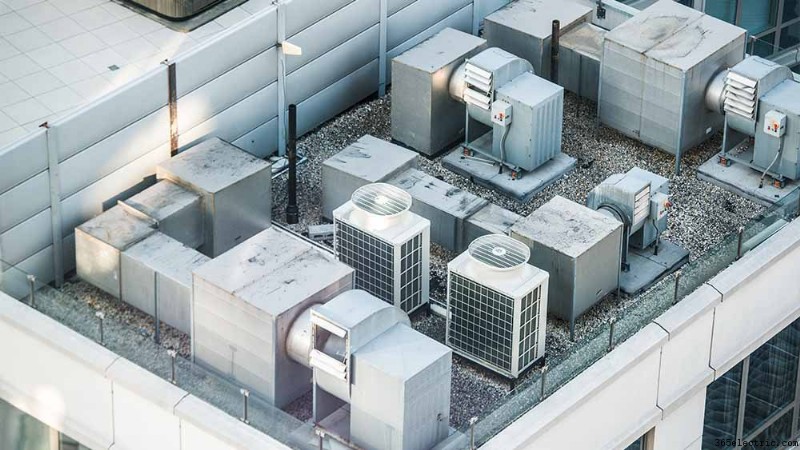
When it comes to choosing an air conditioning unit for commercial use, the following factors are important to consider:
- Building design
- Energy efficiency
- Climate conditions
- Air quality
The first step is to determine the heating and cooling requirements of the space. This will vary depending on the type of business and the number of people that occupy the building.
Next, consider the building’s energy efficiency. In general, newer buildings are better insulated and require less energy to heat and cool. However, older buildings can often be retrofitted with energy-efficient windows, doors, and insulation.
Climate conditions are also an important consideration. For example, mini-splits won’t work when heat waves hit if the building is in an extremely hot and humid climate.
Finally, air quality is another important factor to consider. Indoor air quality can be affected by a number of factors, including off-gassing from building materials, cleaning products, and office equipment. To ensure proper airflow and filtration, it’s important to choose an HVAC system that is sized appropriately for the space and ventilation needs.
Make your AC Smart
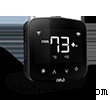
Cielo Breez Plus
Industry Best in Class Smart AC Controller with Local Controls
Shop Now$114$149
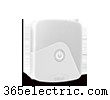
Cielo Breez Eco
Best Valued Smart AC Controller in White
Shop Now$73$99
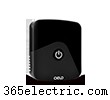
Cielo Breez Eco
Best Valued Smart AC Controller in Black
Out of Stock$68$99
Is Commercial Building HVAC System Maintenance Worth the Expense?
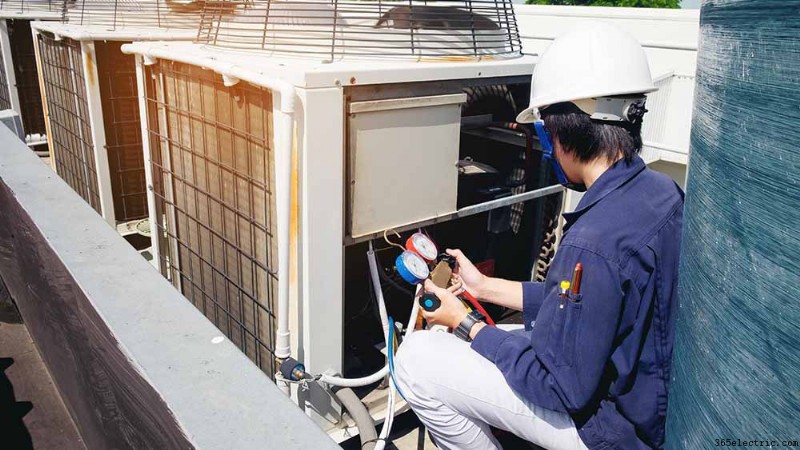
A typical commercial building HVAC system is a complex network of air conditioning components, including air ducts, air filters, coils, and blowers. To keep this system running smoothly, it is important to perform regular maintenance.
Usually, commercial HVAC maintenance may be too costly, but it saves a lot in the long run. For example, regular maintenance can extend the durability of your equipment. Additionally, properly maintained HVAC systems tend to have lower operating costs, so you’ll save money on your energy bills each month. Finally, regular maintenance can help ensure the comfort of your tenants or customers by keeping the temperature and humidity always at a comfortable level. When you weigh all the factors, it’s clear that investing in maintenance for your commercial HVAC system is a thrifty decision.
Here are the most important things to tick off your regular HVAC maintenance list:
- Inspect air filters and clean or replace them as needed
- Clean the condenser and evaporator lines
- Check for blockages in the air ducts
- Inspect the drain lines to ensure they’re not clogged
- Test the thermostat readings to make sure it’s accurate
Additionally, follow these detailed commercial HVAC maintenance tips to ensure your system runs smoothly and efficiently throughout the year.
How Do Commercial Air Conditioners Differ From Residential Systems?
When it comes to climate control, commercial HVAC systems are in a class of their own. These heavy-duty systems are designed to cool or heat large spaces quickly and efficiently.
Here’s a closer look at some of the key ways that commercial units differ from residential HVAC systems.
| Commercial HVAC System | Residential HVAC System |
| Size | Larger | Smaller |
| Operating Power | More powerful | Less powerful |
| Placement | Roofs or utility rooms | Inside homes |
| Cost | Less expensive | More expensive |
| Maintenance | Requires less maintenance | High maintenance |
| Drainage | Complex | Simple |
Commercial HVAC systems are a vital part of any business, and it’s important to understand the different types and how they work before making a purchase. By considering factors such as size, usage, and climate, you can choose the best system for your needs and ensure that your employees or customers stay comfortable all year long. Maintenance is important for any commercial air conditioner, but the cost-benefit analysis can be tricky. However, carrying out regular AC tune-ups can save you money in the long run.









